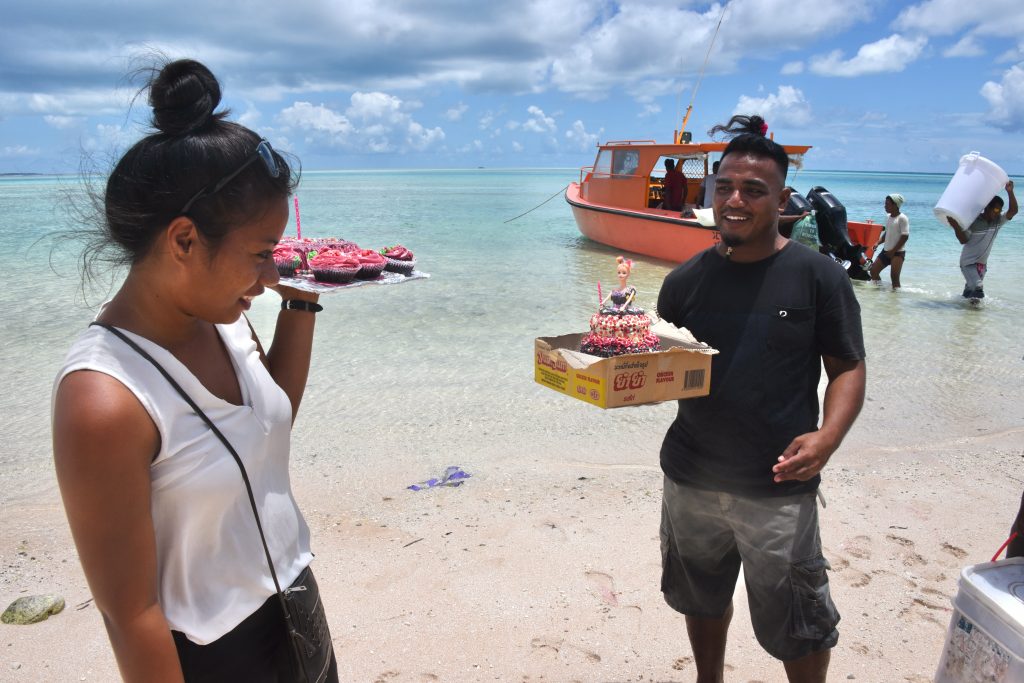
KIRIBATI
Territorial waters which extend 5000 kilometers from west to east and 2000 kilometers from north to south. Roughly half-way between Hawaii and Australia, there are 32 atolls, small dots in an vast expanse of blue which together add hardly to more than the size of the city-state of .Singapore. 15.000 kilometers. The dots are called Kiribati. 300 years ago when Captain James Cook was preparing his ship to set sail for the Pacific, signing 100 men on as officers, helmsmen, sailors, cooks, astronomers, botanists and cartographers, he had bought provisions to be able to survive for at least two years.Nowadays it were „just” 18 flight hours (layovers not counted) or 15.000 kilometers from my home village in Germany to South Tarawa, capital of Kiribati, via Hong Kong, Guam, Pohnpei in the FSM and Majuro on the Marshall Islands.
The boat from South Tarawa to the atoll of Abaiang, 60 km north of the capital in a beautiful lagoon took an additional 2 hours. Underway we passed dozens of Chinese fishing vessel using their catch to satisfy their compatriates’ insatiable hunger for seafood. Upon arrival on the southernmost point of the atoll I was suddenly aware that I was probably at the remotest place I had so far ever been. Passengers and goods were brought with a smaller boat ashore, where, shaded under palm trees, Abaiang’s only vehicle was offering onward transport. We climbed on its rear loading space, squeezed between other passengers, sacks of raw sugar, a a child’s bicycle, a window frame and all kinds of other merchandise. There was no haggling for any fare, as it was included in the boat trip. Ample time for chatter between the newly arrived and the folk who had stayed behind on the island. As always there is nowhere more gossip exchanged than on islands. I did not dare to ask, but I was curious whether they were sometimes discussing the possibility of a mass exodus to land on more elevated Fiji which the Kiribati government had already purchased in 2014? As contingency planning for climate change as all 32 atolls were low-lying. Sometime the lorry set off on the only navigable road of Abaiang, a sandy track, stretching 45km to the northernmost point. My view from the loading space was like browsing through a coffee table book about beautiful tropical landscapes, with white sandy beaches and crystalline shallow lagoons on my left and the rhythmic crash of the Pacific on my right. Palm trees and breadfruit trees as well as pandanus trees took turns in providing shade. Children were playing catch me if you can while the adults were whiling the hot daytime away in one of their buia meeting houses.
After an hour or so, I caught myself almost wishing this beautiful trip would never end. But soon a couple of thatched-roof houses, all purposely built on stilts, signalled the arrival of a little village. The driver dropped us and we walked a few meters to Terau Beach Bungalows, a cute wooden overwater hut which would serve as our home for the next free days. We swam in the paradisiacal lagoon right in front of our hut, celebrated that we were probably the only tourists on the entire island and set off for a snorkelling trip to an outer atoll. On our return we landed with our boat further north, at Ubwanteman Village. For us, the only tourists, the entire village had been up in arms and dressed to their finest costumes, offering us a kind of Bavarian-Micronesian folk dance, including alternateslapping! Chief Tera proudly confessed that his entire village was exercising three times a week, and that he had seen the world: Like generations of Kiribatis, Chief Tera was a graduate of the Marine Training Center in South Tarawa. As sailor he had been as far as Hamburg and Bremerhaven and said he loved shopping. Now it was my time to shop as he sold me his beautiful woven sleeping mat.
After another dip into the turquoise lagoon we were chatting with our wonderful hosts Sinaii and Kaboua, both natives from Abaiang. Kaboua works as scientist trying to boost the usage of coconuts for further development and hopes to turn Abaiang into an organic island. Sinaii, being just 32, has already brought it to the role as “Youth Ambassador of Kiribati”. In this capacity, Sinaii now travels travels around the world and just had come back from trying to raise awareness for the challenges of Climate Change from France. She said that it was much warmer than ever before on Abaiang, and that sometimes seawater was even to warm for a cooling swim. In those good old days, there was an eternal change between low and high tide. But since a while, she said with some sadness in her eyes, there was, at least once a year, a fearful „King Tide“ which was flooding the entire island, being at some places a mere 100m wide. I suddenly feel bad about my carbon footprint (albeit it was mostly for business and intercultural collaboration and understanding).
Questioned whether she could imagine living somewhere else, Sinaii offers me a forgiving smile and is leaving no doubt: No, only on Abaiang!
